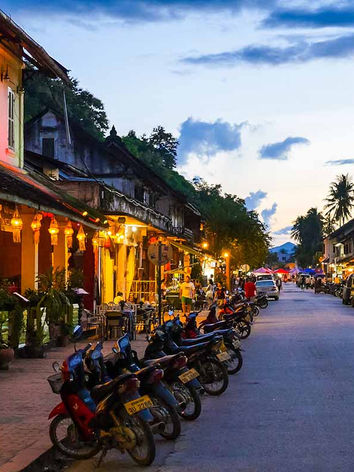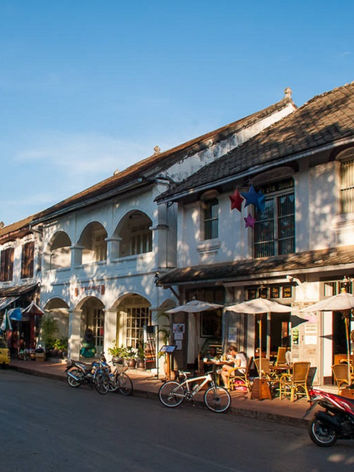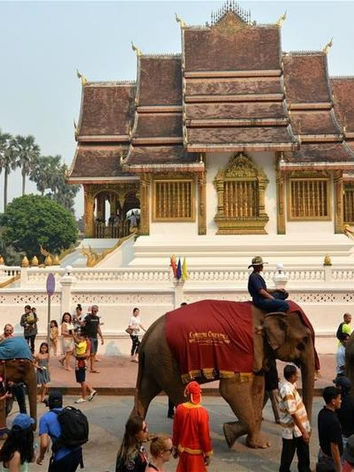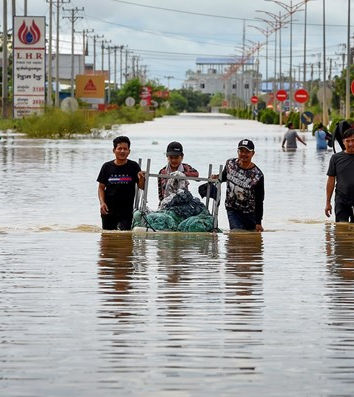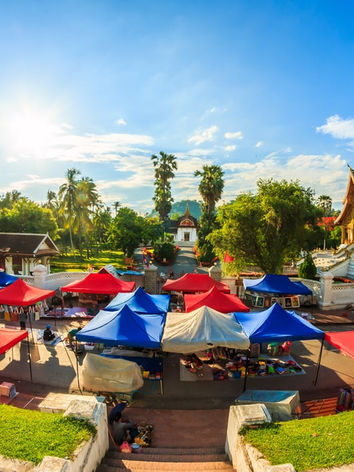

SAVE UNESCO'S
WORLD HERITAGE SITES

The Town of Luang Prabang is the capital and administrative center of Luang Prabang province. It is located approximately 300 km north of Vientiane. Nowadays, the city has a population of about 56,000, of which about 24,000 are residents of UNESCO protected sites. The city, located on a peninsula at the confluence of the Nam Khan and Mekong Rivers, consists of four main roads.
The town of Luang Prabang, literally meaning "Royal Buddha", consists of 58 adjacent villages, most of which make up the UNESCO Luang Prabang World Heritage Site. In 1995, the town was inscribed on the World Heritage List for its distinctive and "remarkable" well-preserved tangible and intangible heritage, which includes centuries of rural and urban development, including the influence of French colonialism.
There is archaeological evidence that the earliest inhabitants of Luang Prabang dating back to 8,000 B.C. In the 14th century, King Pharm founded the first Lao kingdom of Lien Xang after conquering and uniting the present-day provinces of Xieng Khouang, the Khoulat Plateau and Luang Prabang. Shortly after that, the king accepted a golden statue of Buddha from the Khmer monarchy known as Palabang. In response, he renamed the prosperous city-state Luang Prabang.

In the mid 17th century, the city firstly contacted the West under King Surigna Vongsa. Luang Prabang was the administrative center of Lengsang until 1560 when King Sethahira moved the capital to Vientiane. Nonetheless, Luang Prabang is still the main religious center of the country.
This kingdom split into a separate country which contained Vientiane, Champasak, and Luang Prabang after he died in 1694. At the end of the 19th century, Luang Prabang was under attack by local bandits. Many historical heritages like sacred Buddha statues, temples and was destroyed.
King Sisavang initiated a series of renovation and embellishment program in Luang Prabang, many of which exist nowadays. In the late 19th century, French-influenced architecture began to appear, adding to the mix of local architecture, Burmese, Chinese and Thai.
UNESCO declared Luang Prabang a World Heritage Site for its magnificently preserved temples, traditional wooden dwellings, colonial houses and natural surroundings at the end of the 20th century.

Outstanding Universal Value (OUV)
The mix of styles and various materials reflects the richness of Luang Prabang's architecture. Most of the architectures are of traditional construction. Only the temples are made of stone, while one- or two-story brick houses characterize the town's colonial period. Richly decorated with sculptures, paintings, gilding and furniture pieces, stupas in this town are considered the most sophisticated Buddhist temples in the world.
Most traditional Lao buildings use traditional techniques and materials that were introduced during the colonial period, like woven bamboo panels painted with thorns. Brick colonial buildings, often with balconies and other wooden decorative features, line the main streets and the banks of the Mekong River.


Luang Prabang is also a concentration of religious culture, with many temples and monasteries, and has been a place of high spiritual significance to Buddhists throughout history. Monks teach young generations the techniques of heritage restoration, so that religious buildings are regularly maintained. In addition, Buddhist worship and traditional culture (ceremonies and rituals) are still alive and diligently practised.
For more than 600 years, the locals have been rising early to prepare for the food. Immediately afterwards, locals sat on the roadside sidewalk and waited for the procession of monks. Hundreds of monks from local monasteries meditated while collecting their daily offerings from the followers. This is the Buddhist's culture, a reflection of the synergistic relationship between Buddhist monks and alms-givers. This is evidential of the importance that Luang Prabang plays in keeping intangible heritage alive.
Identification of Threats
Luang Prabang is vulnerable to many natural disasters. Floods and landslides occur from time to time, as well as droughts in some years. The town is located in an earthquake-prone area in northern Laos, and strong geological movements can also irreversible impact the town. Fires can proliferate in the changing climate and environment.
Luang Prabang has undergone rapid change due to an unprecedented increase in tourists and tourist accommodations in human-induced disasters. The authority and integrity of the old town have been challenged by the excessive concentration of tourists and businesses. The dramatic growth of tourism has harmed the landscape of Luang Prabang as well. In addition, traditional Lao houses are being gradually replaced by modern houses under the influence of modern material technology.

Floods are the main natural hazard in this area - in terms of both frequency and consequences. Floods frequently occur in the lower floodplains along the Mekong River and its branches. At the same time, other downstream areas of the country are also affected. These areas cover a large part of the country and are where rice and farming production is centralized. Floods will significantly affect the physical culture of the ancient cities and the surrounding natural landscape. In accordance with the framework for threat assessment, the risk will hence be considered high.
High risk is also posed by tourism. After becoming a World Heritage Site, commercialization has occurred at almost all heritage sites. The consequence of this increased visibility and the continued governmental interest in promoting tourism has been the degradation of sites. The need to cater for tourism outweighs the needs of the local population.
Luang Prabang's status as a World Heritage Site in 1995 was followed by a surge in tourism, with visitor numbers increasing by 890% from 1997 to 2016. In fact, as early as 2004, UNESCO noted in a report that tourism development had already put a “critical stress” on the town’s environmental and cultural resources.
Without proper management, it warned, Luang Prabang could well become “another tourist town where soft-drink billboards dominate the landscape, where the sound of tour buses drowns out the soft temple prayers and where the town’s residents are reduced to the roles of bit-players in a cultural theme park.”
In 2012, the expansion of the airport runway allowed larger aircraft to land and increased the capacity to receive more visitors. Tourist buildings such as hotels, lodges, tours, tourist shops and travel agencies jumped from 87 in 1997 to 786 in 2016, 803%.



The impact of tourism on this heritage site is manifested in two main ways. Firstly, from a spatial point of view, the building materials and roofing materials have changed significantly. In contrast, the three indicators of building height, floor area and building condition have remained unchanged.The second impact is the gentrification of the site. The local community moved out of the town, and virtually every home and mom-and-pop store in the historic center has been converted into a guesthouse, restaurant, café, bar or travel agency. Those who own land and buildings in the old town are Laos people with capital or government officials who can access the funding source. In addition, tourists brought a new way of life to Luang Prabang and left lots of garbage in the city. Due to the rampant rates of tourism and its irreversible effects on Luang Prabang's various heritage assets, its risks are considered high.
Assessment of Conservation Management Plans
In terms of tackling natural disasters, people have already realized that the significance of information for decision makers and city planners to address the hazards successfully and efficiently. The government has established risk overviews of hazards and their impacts at the state and local levels to assess the risk and vulnerability of each area in order to develop effective plans and tactics for emergency response. The government has also developed a database system to collect and analyze disaster and update data regularly.
There is also an early warning system implemented; the Department of Meteorology and Hydrology is required to report disaster hazards to the government and the National Meteorological Agency. The Department of Meteorology and Hydrology needs to work closely with each province and district. This department is an agency under the National Ministry of Natural Resources and Environment. Its main function is to provide meteorological and environmental monitoring and to support the security and sustainable development of society.


The primary role of the system is to provide early warning of any hazards detected through its weather and hydrological facilities stationed throughout the State. The government should work with all departments to establish monitoring procedures. The system receives live data from hydrologic stations to the data center to forecast and warn. Majority of flood warnings are disseminated to the public through media and announcements.
Domestic stations provide data to the Ministry of Meteorology and Hydrology for weather and flood forecasting. The Department of Meteorology and Hydrology also receives regional data, the Internet, satellite ground receiving stations, satellite receiving stations, weather forecasting centers, flood forecasting centers, WMO GTS Bangkok RTH, RBSN and RBCN secondary climate stations, hydrological centers, and national seismic stations. All data are collected through DMH and released to relevant government agencies and the public.
In terms of managing tourism, Luang Prabang has DoICT (Department of Information, Culture and Tourism), whose role is to achieve sustainable tourism. This is done by planning tourism development for promotion and marketing, setting standards, managing guides, hotels and restaurants, conducting training, developing new tourist destinations and promoting sustainable development. In addition, DoICT has a department responsible for culture. The scope of work of this department includes the preservation of intangible cultural heritage (dance and music) and the restoration of temples, as well as collaborative activities with DPL.
In order to carry on traditional skills, DoICT provides training for monks to become competent in the arts. Apart from this, Luang Prabang does not have a more active and effective response to the destruction of the local community's culture brought about by tourism.
The security and development programme (PSMV) has systematic and clear regulations for the conservation and renovation of buildings on heritage sites. However, the regulations did not allow for small-scale extensions or renovations, inconveniencing residents and prompted communities to leave the site gradually. There is also the problem of poor enforcement of the PSMV, particularly with regard to certain renovations brought about by the tourist function, which has also led to a loss of authenticity.
Suggested Conservation Management Strategies
Since most natural disasters are beyond human control, the government should focus on prevention, response and recovery. Existing disaster prevention programs are limited to the level of disaster forecasting. The government should reduce over-development and other human activities that may affect local rivers' landscape, vegetation, and geology.


The government should also regulate the artificial destruction of the natural landscape and introduce relevant policies or laws to regulate it. The existing model faces inefficiencies, duplication of efforts, and unclear division of labour in terms of disaster response. The government should improve the existing system and management structure. Government departments should work closely with local organizations and clarify their respective responsibilities to avoid confusion.
The federal government should coordinate all sectors in order to provide complete relief to the affected areas. In terms of disaster recovery, the government introduced financial and technical support to restore the heritage. However, the professionalism of these teams is questionable. The government should appoint professionals to guide and supervise to ensure the authenticity and authority of the heritage.
In terms of the impact of tourism, the heritage site need to develop a complete and systematic tourism management plan. For example, controlling the flow of visitors, banning photography at religious events and areas, reducing the number of commercial buildings and planning signage within the site in a uniform manner.
In terms of parking and traffic, shutter buses could be set up to transport tourists between the airport and the site, and external vehicles could be banned from entering and parking at the site.
In terms of the planned dam, the government should give up building dams and stop seeking development at the expense of heritage and the natural environment.


The End.
Bibliography
ADPC and UNDRR, 2019, Disaster Risk Reduction in Lao PDR, Asian Disaster Preparedness Center, United Nations Office for Disaster Risk Reduction, Available at https://data.laos.opendevelopmentmekong.net/dataset/disaster-risk-reduction-in-lao-pdr-status-report-2019, (Accessed: 30 October 2021).
Application of Information and Communication Technology to Promote Sustainable Development A Case Study: Town of Luang Prabang, Lao PDR (pdf) Tokyo Institute of Technology, Retrieved October 15, 2021. ● BUFFERING ZONE: Urban planning and Buffer zone, 2019, Department of Luang Prabang Heritage Office, Available at https://www.luangprabang-heritage.org/what-we-do/regulation/buffer-zone/ (Accessed: 30 October 2021).
Ceelia Leong et al., ‘Impact of Tourism Growth on the Changing Landscape of a World Heritage Site: Case of Luang Prabang, Lao PDR’, Sustainability 9, no. 11 (1 November 2017): 1996, https://doi.org/10.3390/su9111996.
Disaster and emergency response, 2021, Open Development Laos, Available at https://laos.opendevelopmentmekong.net/topics/disasters-and-emergency-response/#Rmxvb2RzIGFuZCBTdG9ybXM= (Accessed: 30 October 2021).
Experts renew quake fears over Xayaburi dam on Mekong River in Laos. Tom Fawthrop. South China Morning Post 8 April 2014.
Fawthrop, T., 2020, Hydropower vs Heritage: Will Laos Lose Luang Prabang, The Diplomat, Available at https://thediplomat.com/2020/12/hydropower-vs-heritage-will-laos-lose-luang-prabang/ (Accessed: 30 October 2021).
Jos D. M. Platenkamp, ‘The Canoe Racing Ritual of Luang Prabang’, Social Analysis: The International Journal of Social and Cultural Practice 52, no. 3 (2008): 1–32.
Lao PDR Disaster Management Reference Handbook 2017, 2018, Open Development Laos, Available at https://data.laos.opendevelopmentmekong.net/library_record/lao-pdr-disaster-management-reference-handbook-2017/resource/dc1ebca6-49f1-4892-a57d-cb8b4c8164f8, (Accessed: 30 October 2021).
Nathan Thompson, ‘In Laos, a Dubious Dam Threatens Luang Prabang’, Foreign Policy (blog), accessed 24 October 2021, https://foreignpolicy.com/2021/07/25/laos-luang-prabang-unesco-world-heritage-site-mekong-river-dam-project-hydroelectric/.
‘Project for Capacity Enhancement for Sustainable World Heritage Management and Preservation in Luang Prabang in Lao PDR’, accessed 24 October 2021, https://openjicareport.jica.go.jp/pdf/12340865_01.pdf.
Promkerd, Prasartthong; Khoprasert, Yuvaluk; Virathavone, Phongthep; Thoummabouth, Manivone; Sirisak, Ouane; Jäkel, Thomas (1 March 2008). "Factors explaining the abundance of rodents in the city of Luang Prabang, Lao PDR, as revealed by field and household surveys". Integrative Zoology. 3 (1): 11–20. doi:10.1111/j.1749-4877.2008.00069. x. ISSN 1749-4877. PMID 21396046.
Phill Wilcox, ‘Luang Prabang, a World Heritage Town’, 2020,122-136. http://www.laostudies.org/system/files/subscription/Wilcox.pdf
Phouyavong, S. n.d., Natural Disasters and Mitigative Measures in the Lao PDR Country Report, Available at https://www.adrc.asia/countryreport/LAO/LAOeng98/index.pdf (Accessed: 30 October 2021).
PSMV REGULATION: Heritage Preservation and Development Master Plan, n.d., Department of Luang Prabang Heritage Office, Available at https://www.luangprabang-heritage.org/what-we-do/regulation/psmv/ (Accessed: 30 October 2021).
Séisme de magnitude 6,1 au Laos. Le Figaro 2019.11.21 Laos earthquake hits northern province. Local frightened as buildings sway. Bangkok Post, 22 Nov 2019
STATUS OF CONSERVATION: Luang Prabang, n.d., Department of Luang Prabang Heritage Office, Available at https://www.luangprabang-heritage.org/what-we-do/status-of-conservation/ (Accessed: 30 October 2021). ● Strategy and Priority Program for preservation, 2019, Department of Luang Prabang Heritage Office, Available at https://www.luangprabang-heritage.org/what-we-do/strategy-and-priority-programe/ (Accessed: 30 October 2021).
"Town of Luang Prabang - UNESCO World Heritage Centre". UNESCO. Retrieved October 15, 2021.
Town of Luang Prabang n.d. Available at https://whc.unesco.org/en/list/479/ (Accessed: 30 October 2021).
UNESCO World Heritage Centre, ‘UNESCO World Heritage Centre - State of Conservation (SOC 2021) Town of Luang Prabang (Lao People’s Democratic Republic)’, UNESCO World Heritage Centre, accessed 24 October 2021, https://whc.unesco.org/en/soc/4167/.
United Nations Office on Drugs and Crime (UNODC). 2015. Opium production in Myanmar and the Lao People’s Democratic Republic stabilizes at high levels, says UNODC report. https://www.unodc.org/unodc/en/frontpage/2015/ December/opium-production-in-myanmar-and-lao-pdrstabilizes-at-high-levels-unodc.html

